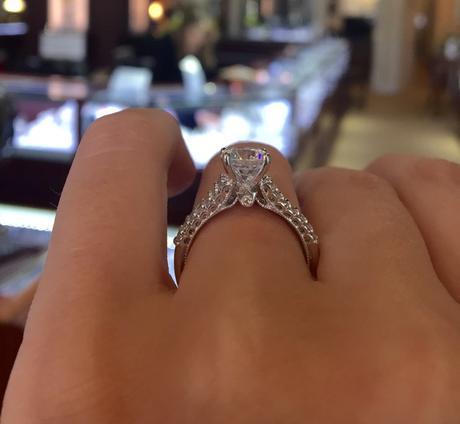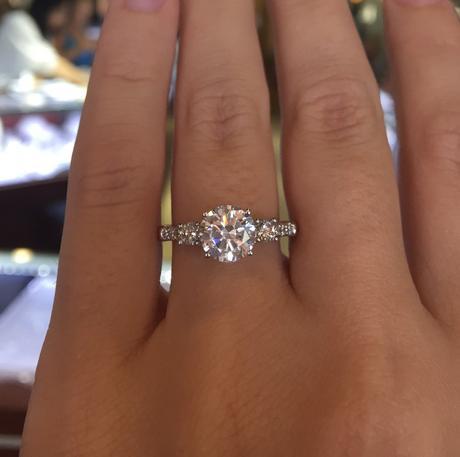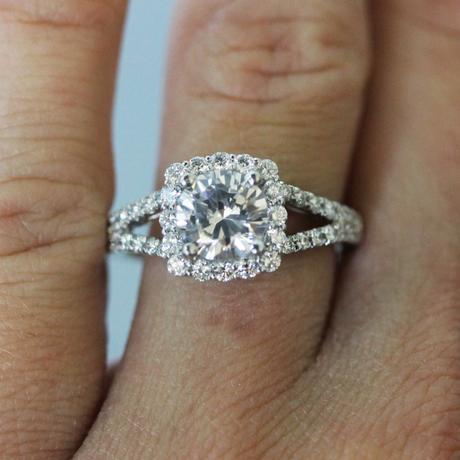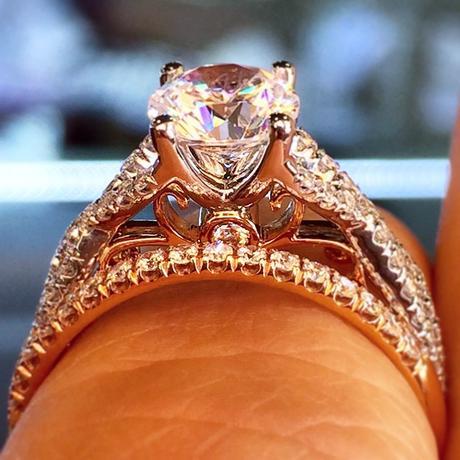Buying an Engagement Ring? These 4 Tips Can Save You $4 GrandWhen you start shopping for an engagement ring, you need to know your basics. Heading into a jewelry store without a little bit of research is like heading to a car dealership without any idea of what you want (or the KBB price you should pay for that sweet convertible you’re eyeing.) So when you’ve found The One and it’s time to ask the big question, your first step should be some recon. I’m not talking about figuring out her ideal ring shape and style either, I’m talking the nitty gritty details that ring shoppers should know. And I’ve written a lot about The 4 C’s, but buying an engagement ring using this guide to each of them can easily save you thousands of dollars.

The 4 C’s – Color, Clarity, Cut and Carat – are the ABC’s of diamond buying. Familiarizing yourself with these terms is the first step of buying an engagement ring, and will make sure you get a beautiful stone for a good price. Your jeweler should work with you and explain each element of the diamond more thoroughly, but it helps if you have some base knowledge before visiting the store. They all start running together once you’ve got the diamonds in front of you, and knowing the difference between what’s visible to the naked eye and what you’ll never notice can save you big bucks. Once you understand the general meaning of each “C”, you’ll understand these tips on how to get the best diamond deal.
Color
When it comes to a diamond’s color, the grading scale begins at D (not A.) AD colored diamonds are completely colorless, very rare, and very valuable. The scale goes all the way to Z, though most fine diamond jewelry only uses diamonds up to K in color. I recommend diamonds in G or H colors to get the best deal for your diamond, because to the untrained eye, they’re still colorless – but you’re not paying the premium for a D colored diamond, or even its two closest colorless grades E, and F. G/H colored diamonds are near colorless, and are very difficult to spot the color in, unless they’re put right next to a D diamond.

Clarity
Clarity measures the small, often microscopic flaws that nearly every diamond has. Most of the time, even when these inclusions or blemishes are present, they are invisible to the naked eye. This scale runs from the very rare FL & IF (flawless and internally flawless, respectably) to I (included. Most respectable jewelers do not carry I diamonds). In between, you have degrees of VVS (very, very slightly included), VS, (very slightly included), and SI (slightly included). The grade each diamond gets depends on the size, type, number and location of inclusions. Almost every single diamond has inclusions. These little marks that most people can’t see without a 10x magnification, serve as diamond “birthmarks” to identify your stone, should you ever need to id your rock.
To get the best price on a budget, I recommend VS diamond over the comparable VVS diamonds. The difference is really undetectable to the untrained eye, with some extra stipulations. Look for VS diamonds with lighter inclusions (white instead of black) that are closer to the perimeter of the diamond, and therefore can be disguised or hidden by the setting.

Cut
A diamond’s cut grade measures its proportions and how well they function to make the diamond shine, sparkle and scintillate. It affects the fire and brilliance, and how the diamond reflects light. GIA cut grades range from excellent at best to poor at worst, I don’t recommend going any lower than a Very Good cut grade (if your budget allows, excellent is the best, but you will pay a premium for this grade that’s only a step above Very Good). It’s important to choose a high cut grade because a diamond cut too shallow will be flat, and have no sparkle or dimension. A diamond cut too deep will look smaller than it is, but an excellent of very good cut diamond will shine brilliantly. And really, what’s the point of a huge diamond if it ain’t gonna shine?
Carat
Carat is the c that most people are familiar with. Carat measures the weight of a diamond, and therefore its size. The most important thing to remember about diamond size is its wearer; a 1 carat diamond will look significantly larger or smaller depending on the wearer’s ring size and how big their hands are. Most people want the biggest diamond they can afford, as long as all the other grades are good too. I recommend getting as close to your ideal carat weight without going over; this is because diamond prices jump drastically at the half carat and carat points, but the difference is undetectable to the naked eye. For example, let’s say a 3 carat, D colored, IF round brilliant diamond is $315,000. A diamond with the same characteristics, weighing 2.99 carats might cost $158,000 – half the price for .01 carats less.
This is because larger, jewelry quality diamonds are more rare, and they’re priced at – you guessed it – a premium.

Once you’ve seen a certificate with the diamond’s characteristics, you can compare it to diamond prices at online retailers, to make sure you’re getting the best price. You can also compare to other local jewelers, as long as every diamond has the same certification – otherwise, one jewelers’ G, VVS is another’s H, SI2 –it’s apples to oranges without the same certificate. I recommend diamonds with a GIA certificate, because they’re the gold standard.
Another detail to look for on a GIA certificate is a diamond’s florescence. We find none to faint an acceptable level, whereas a medium to strong blue stone should be heavily discounted. Otherwise, your diamond will literally glow under blacklight, and will give it a hazy look.

